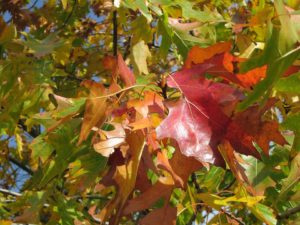THE LEAFLET

Celebrating Our National Tree Round III: Red Oak
The United States of America is a unique, goofy place and Fourth of July seems to bring about a universal patriotic mood – especially in our Nation’s Capital! While eagles typically come to mind as the symbol of the States, did you know the U.S. has an official national tree? Only formally recognized in 2004 (!) Congress named the Oak tree as our national tree. No species, just the genus Quercus. To celebrating this stately tree, and our beloved country, we’re spending the month of July highlight Oak species prevalent in D.C. Next up is the Red Oak, the third most common of street tree oaks!
D.C. has been sunny and beautiful lately, but brutally hot. With forecasted temperatures in the nineties, escaping the early summer heat may seem an impossible feat.
 Cue the northern red oak (Quercus rubra). With dense leaf coverage and a typical height of almost 100 feet, the Northern red oak is one of the best shade trees D.C. has to offer on scorching afternoons.
Cue the northern red oak (Quercus rubra). With dense leaf coverage and a typical height of almost 100 feet, the Northern red oak is one of the best shade trees D.C. has to offer on scorching afternoons.
The northern red oak is native to the northeast region of the United States and southeast Canada. You can recognize the tree by its distinctive bark, leaves, and acorns. Mature trees have dark grey or brown bark with broad, shiny strips on the trunk’s ridges. Its leaves are lustrous dark green on both sides, with seven to eleven sharp lobes. The tree’s acorns are typically two to three centimeters long and have a reddish-brown cup on one end. Unlike the white oak, a red oak’s acorns stay on the tree through the winter.
Red oak seedlings need to be planted in open areas, as they require a light intensity of about 30 percent to grow. Small sprouted trees should be given a planting space of at least 8.5 square meters. If you are interested in planting a northern red oak tree, check out our Tree Rebate Program! The red oak qualifies as one of our rebate program’s large shade trees likely to thrive in the District. You can find red oaks in a lot of places in D.C. including McPherson Square, Cleveland Park, Dumbarton Oaks, Logan Circle and Woodland-Normanstone.
Northern red oak facts:
- Northern red oaks can thrive in forests and cities, as long as they have enough space.
- They have a fast growth rate of about 2 feet per year.
- Northern red oaks’ acorns are a treat for many animals, including ruffed grouse, blue jays, wild turkeys, fox squirrels, bears, deer, and raccoons.
- On rare occasions, the red oak can live to be 500 years old! More commonly, they tend to stay healthy for about 150 years.
As temperatures continue to climb, keep your eyes peeled for these wonderful shade trees. They can help you escape from the blistering heat but still enjoy the beautiful weather!
Editor’s note: We originally posted this Red Oak profile in 2011 as part of our Tree of the Month series.
Check out all the other Oaks we’ve highlighted in July:
Round I: Willow Oak (the most common street tree oak)
Round II: Pin Oak (the second most common street tree oak)